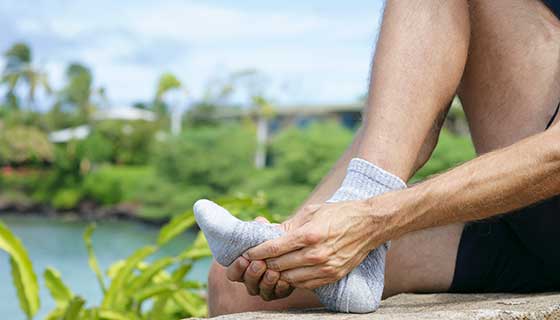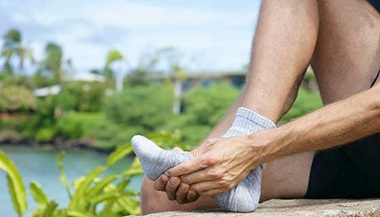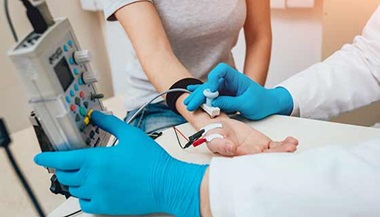Stiff Person Syndrome (SPS)
People who have stiff person syndrome can experience severe muscle spasms and other unpleasant symptoms that can worsen without treatment.
What You Need to Know
- Stiff person syndrome is named after the symptoms that were originally described with the condition: episodes of muscles locking up and becoming stiff as a board.
- People with SPS can have other symptoms, which are thought to be related to the type of SPS they have.
- SPS was once known as stiff man syndrome, but it is more common in women.
- No treatment eliminates or cures SPS, but medications and other therapies can help manage symptoms and improve quality of life, and some treatments may help prevent disease progression.
What is stiff person syndrome?
Stiff person syndrome is a rare autoimmune neurological disorder that most commonly causes muscle stiffness and painful spasms that come and go and can worsen over time. However, some people experience other symptoms such as an unsteady gait, double vision or slurred speech. SPS symptoms are thought to be related to which type of SPS a person has.
Although there is no treatment that cures stiff person syndrome, working with a specialist and maintaining symptom control can make it easier to live with the condition.
SPS most commonly develops in people ages 40 to 50, but in rare cases, it occurs in children and older adults. SPS is thought to affect one to two people in a million. However, SPS experts now consider the syndrome to be a spectrum of disorders, which means it is likely more common than originally thought, although still rare.
Stiff Person Syndrome Symptoms
Stiff person syndrome most often causes painful muscle contractions and spasms that often begin in the legs and back. Spasms can also affect the abdomen, and less often the upper trunk, arms, neck and face.
The spasms can occur in episodes, especially when a person with SPS is surprised or startled, or moves suddenly. Cold temperatures and emotional stress can also set off a muscle spasm. In some people, the spasms are brought on by certain exercises or touch.
The areas where muscle contractions occur can be stiff and board-like. Depending on which part of the body is affected, the contractions can cause:
- Difficulty walking, and the person might space the feet wide to feel more steady
- A stiff or rigid posture due to ongoing spasms in the back or trunk
- Unsteadiness and falling because of sudden spasms, which can lead to injuries
- Shortness of breath if SPS affects muscles in the chest
- Chronic pain
- Exaggerated curve (hyperlordosis) in the lower back that develops over time due to muscle tightness, and changes in the spine alignment can lead to spinal cord compression (myelopathy)
- Anxiety and agoraphobia due to falls caused by spasms
Other less typical symptoms include eye movement problems that cause double vision, speech issues and lack of coordination.
SPS symptoms do not appear in a specific order. For some people, the condition starts with cramps or stiffness in the legs that become gradually worse over weeks, months and years. Others may experience different symptoms before muscle spasms.
Types of Stiff Person Syndrome
Classic Stiff Person Syndrome
Most people with SPS have the classic form. Symptoms include stiffness and spasms in the muscles of the lower back, legs (more than arms) and sometimes abdomen. People with classic SPS may have frequent muscle spasms and walk with a stiff gait, and they can be in pain most of the day.
Partial Stiff Person Syndrome
Less commonly, people with SPS can have partial SPS, sometimes called stiff limb syndrome, stiff leg syndrome or stiff trunk syndrome. With partial SPS, tight muscles and spasms are limited to a specific area, usually one leg. For most people with partial SPS, spasms and contractions do not affect the trunk but, in some cases, they affect part of the chest or abdomen.
Stiff Person Syndrome Plus
Another less common type of the syndrome is SPS plus, which is best described as a combination of classic features (spasms and stiffness) and symptoms that suggest brainstem and/or cerebellar dysfunction. People with SPS plus can have muscle spasms and rigidity along with lack of coordination, double vision, slurred speech and other symptoms.
Other Less Common SPS Types
Other less common SPS conditions that some experts identify as part of the SPS spectrum of disorders include progressive encephalomyelitis with rigidity and myoclonus (PERM), predominant/pure cerebellar ataxia and overlapping syndromes. These types most often have symptoms and exam findings that suggest dysfunction in the brainstem, cerebellum, spinal cord and/or cerebrum.
What causes stiff person syndrome?
Much needs to be learned about how stiff person syndrome develops. It is believed to be an autoimmune disorder — in autoimmune conditions, the body’s immune system attacks healthy tissues. Similar to other autoimmune conditions, SPS affects more women than men.
Most people with stiff person syndrome have unique antibodies in their blood that are made by the body. These antibodies, which block the glutamic acid decarboxylase (GAD) enzyme, are called anti-GAD65 antibodies. GAD helps make the gamma-aminobutyric acid (GABA) neurotransmitter.
When GABA is produced in the body in the right amount, it reduces or blocks certain nerve signals. If GABA doesn’t function as expected, nerve cells can act in incorrect ways. For people with stiff person syndrome, the nervous system becomes hyperexcitable without the proper amount of GABA. This results in physical symptoms such as muscle spasms as well as psychological symptoms, including anxiety. The common triggers (e.g., being startled) of SPS symptoms are also thought to be related to GABA pathway disruption.
SPS is often associated with other autoimmune disorders, including type 1 diabetes, thyroid disorders, pernicious anemia and, less often, vitiligo.
Cancer is rarely associated with SPS (in less than 5% of cases). When cancer is found in people with SPS, it is most commonly breast or lung cancer, and it is typically identified within a few years after SPS symptoms start. Cancer associated with SPS is called paraneoplastic SPS.
Stiff Person Syndrome Diagnosis
Stiff person syndrome is very rare and complex, and its many symptoms can be caused by other, more common conditions. It may take time and several tests to diagnose SPS. If your doctor suspects that your symptoms are due to stiff person syndrome, he or she will review your detailed medical history and perform a physical exam followed by a diagnostic workup. A doctor may make a diagnosis of SPS when there is no better explanation for the symptoms and exam findings.
The following tests can help confirm an SPS diagnosis:
- Blood tests are performed to look at several factors, including the anti-GAD65 antibody. This antibody is present in up to 80% of patients who have classic SPS, and very high levels of the antibody are strong indicators of the condition. Other antibody tests associated with SPS include those to detect the glycine receptor antibody and the amphiphysin antibody. Blood work can also check for non-SPS related antibodies, hemoglobin A1c and vitamin deficiencies.
- Electromyography (EMG) evaluates the body’s nerve and muscle function. If you are taking medications to manage symptoms, such as muscle relaxers, it is important to hold off taking them before this test. This will make your symptoms worse for a short amount of time, but signs of SPS may be easier to see on the EMG.
- A lumbar puncture can help the doctor rule out other causes of your symptoms, as well as help look for SPS markers such as anti-GAD65 antibodies.
- Imaging studies can help your doctor visualize your brain, spinal cord, nerves and other body structures. Usually, imaging studies are performed to rule out other conditions that can seem like SPS. These tests may include MRI of the brain and spine and whole-body fluorodeoxyglucose-positron emission tomography (FDG-PET) with a computerized tomography (CT) scan. FDG-PET with a CT scan and mammogram are also done when there is concern about an underlying cancer.
After the diagnostic workup, your doctor will review the test results with you. If the SPS diagnosis is confirmed, the next priority is creating a custom treatment plan to address your symptoms and prevent them from worsening. Most people with SPS do not need hospitalization as part of treatment. Once the doctor has tailored a plan, you should have regular follow-up visits.
Stiff Person Syndrome Treatment
Stiff person syndrome is a complex condition that affects people in different ways. Also, different types of SPS may require different treatment approaches. A personalized SPS treatment plan typically addresses the syndrome’s autoimmune, neurologic, visual, mobility and pain aspects.
Although currently, no therapy makes stiff person syndrome go away, treatment can help minimize the severity of symptoms and improve quality of life.
Medications to Manage Symptoms
Some medications help reduce spasms, stiffness and pain for people with stiff person syndrome:
- Oral muscle relaxers, such as diazepam, clonazepam, baclofen or tizanidine
- Oral medications that are not muscle relaxers but that have some effect on the GABA neurotransmitter, including gabapentin, pregabalin and tiagabine
- Botulinum toxin, which is sometimes used when there are distinct areas of muscle spasm/tightness
Other medications, such as serotonin reuptake inhibitors (SSRIs), can be added to address physical symptoms triggered by anxiety.
Medications to Target the Immune System
Immune therapies aim to modify or suppress the immune system. Immune-based therapies for stiff person syndrome include:
- Intravenous (injected into a vein) or subcutaneous (given as an infusion under the skin) immunoglobulin
- Plasma exchange
- Intravenous immunosuppressant therapy (e.g., rituximab)
- Oral immunosuppressant therapy (e.g., mycophenolate mofetil, azathioprine)
Other Treatments
Together with medications, nonmedication therapies can make stiff person syndrome symptoms more manageable. Examples include:
- Physical therapy that focuses on stretching, deep tissue myofascial techniques, balance/gait, ultrasound therapy and heat therapy
- Aquatic therapy (very warm temperature)
- Heating pads
- Transcutaneous electrical nerve stimulation
- Stretching
- Osteopathic manipulation
- Qi gong
- Chiropractic treatments
- Massage
- Yoga
- Acupuncture
- Acupressure
- Pilates training
- Cognitive behavioral therapy
These treatments may have different effects for each person with SPS and are worth trying. A combination of medication and nonmedication treatments seems to be the most effective in minimizing the severity and intensity of symptoms over time, but it takes a while to figure out the combination that works best.
Medication to Avoid If You Have SPS
Follow your doctor’s instructions regarding medication. In general, people with stiff person syndrome should avoid:
- Serotonin-norepinephrine reuptake inhibitors such as duloxetine and venlafaxine
- Tricyclic antidepressants such as amitriptyline and nortriptyline
- Narcotics such as oxycodone, hydrocodone, morphine and morphine derivatives, and drugs that contain these substances
- Alcohol can be dangerous, especially for people who are on medications such as diazepam and clonazepam
Stiff Person Syndrome Center at Johns Hopkins
An experienced treatment team is important in managing SPS. Our specialized center, led by Scott Newsome, D.O., combines experts in neurology, immunology, ophthalmology, neuromuscular disease and other specialties to offer comprehensive care for people with SPS.
Living with Stiff Person Syndrome
Stiff person syndrome affects people differently. The type and severity of symptoms and how fast they worsen vary from person to person. Many patients with SPS can manage their symptoms by working with a doctor who is familiar with SPS and by adhering to a multipronged treatment plan.
Does stiff person syndrome require lifelong treatment?
It may. Without treatment, stiff person syndrome can cause more severe symptoms such as spasms that limit mobility, increase the risk of falls with injuries and reduce quality of life. Presently, SPS treatment addresses symptoms but does not eliminate the cause. However, researchers are trying hard to uncover the cause(s) of the disease in hopes to help develop therapies that are more targeted. Some experts feel that immune-based therapies can help limit the progression of SPS for some people, and they advocate for these treatments long term.
Will I need a wheelchair if I have stiff person syndrome?
Some people with stiff person syndrome who have higher levels of disability may need help walking and moving around in other ways, and their activities can become limited. Some eventually need a wheelchair, but many do not.
Is stiff person syndrome fatal?
Death from stiff person syndrome is rare and typically does not result from the disease itself but from its complications such as blood clots or wound infections due to immobility. In some extreme cases, spasms of the chest muscles can affect a person’s ability to breathe.
Can changes to diet or lifestyle help manage stiff person syndrome?
Data is limited on whether specific foods or diets impact stiff person syndrome. Healthy lifestyle choices have shown to help people with other autoimmune diseases, and they are encouraged. Keeping mobile is important, and it is possible when using a combination of medication and nonmedication treatments.






